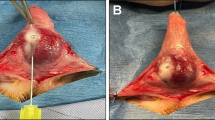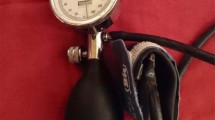Abstract
We developed a rat model of traumatic arteriogenic erectile dysfunction (ED) for the study of vasculogenic ED. Bilateral ligation of the internal iliac artery was performed on 30 three-month old male Sprague–Dawley rats as an experimental group. The control group consisted of 12 rats which underwent dissection of the internal iliac artery without ligation. Before their euthanization at 3 days, 7 days, and 1 month (10 rats in the experimental group and four rats in the control group at each time point), erectile function was assessed by electrostimulation of the cavernous nerves. Penile tissues were collected for nicotinamide adenine dinucleotide phosphate (NADPH) diaphorase staining, trichrome staining, electron microscopy and RT-PCR for transforming growth factor beta (TGF-β1), insulin like growth factor-I (IGF-I) and fibroblast growth factors (FGF) mRNA expression. Electrostimulation of the cavernous nerves revealed a highly significant declining of the intracavernous pressure after 3 and 7 days. No significant recovery of erectile function was noted at 1 month. Histology showed degeneration of the dorsal nerve fibers in all experimental rats. There was little decrease in the bulk of intracavernous smooth muscle in the experimental rats euthanazed 7 and 30 days. NADPH diaphorase staining revealed a significant decrease in nitric oxide synthase (NOS) containing nerve fibers in the dorsal and intracavernosal nerves in all rats in the experimental group. Electron microscopy showed a variety of changes such as collapse of sinusoids, increased cell debris, fibroblast and myofibroblast loss, intracellular deposition of fat and collagen and fatty degeneration. RT-PCR revealed up-regulation of TGF-β1 after 3 days but not after 7 days or 1 month. There is no significant difference in IGF-I or FGF expression between the experimental and control group. Bilateral ligation of internal iliac arteries produces a reliable animal model for traumatic arteriogenic ED. Further studies are needed to investigate the molecular mechanism of ED in this model.
This is a preview of subscription content, access via your institution
Access options
Subscribe to this journal
Receive 8 print issues and online access
$259.00 per year
only $32.38 per issue
Buy this article
- Purchase on Springer Link
- Instant access to full article PDF
Prices may be subject to local taxes which are calculated during checkout
Similar content being viewed by others
References
Lue TF et al. Hemodynamics of erection in the monkey. J Urol 1983 130, 1237–1241.
Juenemann KP, Luo JA, Lue TF, Tanagho EA. . Further evidence of venous outflow restriction during erection. Br J Urol 1986 58, 320–324.
Vardi Y, Siroky MB. . Hemodynamics of pelvic nerve induced erection in a canine model. I. Pressure and flow. J Urol 1990 144, 794–797.
Virag R, Bouilly P, Frydman D. . Is impotence an arterial disorder? A study of arterial risk factors in 440 impotent men. Lancet 1985 26;1(8422), 181–184.
Saenz de Tejada I et al. Impaired neurogenic and endothelium-mediated relaxation of penile smooth muscle from diabetic men with impotence. New Engl J Med 1989 20, 1025–1030.
Goldstein I et al. Radiation-associated impotence. A clinical study of its mechanism. JAMA 1984 251, 903–910.
Rosen MP et al. Arteriogenic impotence: findings in 195 impotent men examined with selective internal pudendal angiography. Young Investigator's Award. Radiology 1990 174, 1043–1048.
Levine FJ, Greenfield AJ, Goldstein I. . Arteriographically determined occlusive disease within the hypogastric-cavernous bed in impotent patients following blunt perineal and pelvic trauma. J Urol 1990 144, 1147–1153.
Heaton JP et al. Coronary artery bypass graft surgery and its impact on erectile function: a preliminary retrospective study. Int J Impot Res 1996 8, 35–39.
Benson G. . Male sexual function, emission and ejaculation. In: Knobil E, Neil J (eds). The Physiology of Reproduction Raven Press: New York 1988 1121–1139.
Aboseif SR et al. Erectile response to acute and chronic occlusion of the internal pudendal and penile arteries. J Urol 1989 141, 398–402.
Azadzoi KM, Saenz de Tejada I. . Hypercholesterolemia impairs endothelium-dependent relaxation of rabbit corpus cavernosum smooth muscle. J Urol 1991 146, 238–240.
Kim JH et al. Experimental hypercholesterolemia in rabbits induces cavernosal atherosclerosis with endothelial and smooth muscle cell dysfunction. J Urol 1994 151, 198–205.
Gray GD, Smith ER, Dorsa DM, Davidson JM. . Sexual behavior and testosterone in middle-aged male rats. Endocrinology 1981 109, 1597–1604.
Heaton JP, Varrin SJ, Morales A. . The characterization of a bio-assay of erectile function in a rat model. J Urol 1991 145, 1099–1102.
Saenz de Tejada I, Goldstein I, Krane RJ. . Local control of penile erection, smooth muscle and endothelium. In: Krane RJ (ed). Urol Clinc North Am Impotence WB Saunders: Philadelphia 1988 9–15.
Ignarro LJ et al. Nitric oxide and cyclic GMP formation upon electric field stimulation cause relaxation of corpus cavernosum smooth muscle. Biochem Biophys Res Commun 1990 170, 843–850.
Burnett AL et al. Nitric oxide: a physiologic mediator of penile erection. Science 1992 257, 401–403.
Breza J et al. Detailed anatomy of penile neurovascular structures: surgical significance. J Urol 1989 141, 437–443.
Paick JS, Donatucci CF, Lue TF. . Anatomy of cavernous nerves distal to prostate: microdissection study in adults male cadavers. Urology 1993 42, 145–149.
Anvar MD et al. Vascular and stromal features in the skin of the lower limb in patients with chronic critical limb ischaemia (CLI) and oedema. Eur J Vasc Endovasc Surg 2000 20, 125–131.
Mashiko T, Ookawara S, Mato M. . Ultrastructural study on intracerebral small blood vessels and fluorescent granular perithelial (FGP) cells in experimental cerebral ischemia. No To Shinkei 1999 51, 871–878.
Moussa ME et al. Effect of total hepatic vascular exclusion during liver resection on hepatic ultrastructure. Liver Transpl Surg 1996 2, 461–467.
Zauberman H, Livni N. . Experimental vascular occlusion in hypercholesterolemic rabbits. Invest Ophthalmol Vis Sci 1981 21, 248–255.
Sporn MB, Roberts AB. . Transforming growth factor-b: recent progess and new challenges. J Cell Biol 1992 119, 1017–1020.
Terrell TG, Working PK, Chow CP, Green JD. . Pathology of recombinant human transforming growth factor b-1 in rats and rabbits. Int Rev Exp Pathol 1993 34, 43–67.
Border WA, Ruoslahti E. . Transforming growth factor-b in disease: the dark side of tissue repair. J Clin Invest 1992 90, 1–7.
Hafez HM et al. Endotoxemia during supraceliac aortic crossclamping is associated with suppression of the monocyte CD14 mechanism: possible role of transforming growth factor-beta1. J Vasc Surg 2000 31, 520–531.
Densem CG et al. Polymorphism of the transforming growth factor-beta 1 gene correlates with the development of coronary vasculopathy following cardiac transplantation. J Heart Lung Transplant 2000 19, 551–556.
Slevin M et al. Serial measurement of vascular endothelial growth factor and transforming growth factor-beta1 in serum of patients with acute ischemic stroke. Stroke 2000 31, 1863–1870.
Vinores SA et al. Increased vascular endothelial growth factor (VEGF) and transforming growth factor beta (TGFbeta) in experimental autoimmune uveoretinitis: upregulation of VEGF without neovascularization. J Neuroimmunol 1998 14, 43–50.
Jung CW, Spencer M, Lue TF. . Growth hormone enhances regeneration of nitric oxide synthase-containing penile nerves after cavernous nerve neurotomy in rats. J Urol 1997 157(Suppl), 413.
Tsuboi R, Rifkin DB. . Recombinant basic fibroblast growth factor stimulates wound healing in healing-impaired db/db mice. J Exp Med 1990 1: 172, 245–251.
Uhl E et al. Basic fibroblast growth factor accelerates wound healing in chronically ischaemic tissue. Br J Surg 1993 80, 977–980.
Corral CJ et al. Vascular endothelial growth factor is more important than basic fibroblastic growth factor during ischemic wound healing. Arch Surg 1999 134, 200–205.
Yanamoto H et al. Infarct tolerance induced by intra-cerebral infusion of recombinant brain-derived neurotrophic factor. Brain Res 2000 24, 240–248.
Larsson E et al. Evidence for neuroprotective effects of endogenous brain-derived neurotrophic factor after global forebrain ischemia in rats. J Cereb Blood Flow Metab 1999 19, 1220–1228.
Hu J, Saito T, Abe K, Deguchi T. . Increase of ciliary neurotrophic factor (CNTF) in the ischemic rat brain as determined by a sensitive enzyme-linked immunoassay. Neurol Res 1997 19, 593–598.
Unoki K, LaVail MM. . Protection of the rat retina from ischemic injury by brain-derived neurotrophic factor, ciliary neurotrophic factor, and basic fibroblast growth factor. Invest Ophthalmol Vis Sci 1994 35, 907–915.
Author information
Authors and Affiliations
Rights and permissions
About this article
Cite this article
El-Sakka, A., B Yen, T., Lin, C. et al. Traumatic arteriogenic erectile dysfunction: a rat model. Int J Impot Res 13, 162–171 (2001). https://doi.org/10.1038/sj.ijir.3900668
Received:
Accepted:
Published:
Issue Date:
DOI: https://doi.org/10.1038/sj.ijir.3900668
Keywords
This article is cited by
-
Initial validation of a novel rat model of vasculogenic erectile dysfunction with generalized atherosclerosis
International Journal of Impotence Research (2005)
-
Characteristics of erectile dysfunction in Saudi patients
International Journal of Impotence Research (2004)



